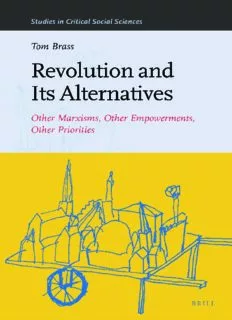
Revolution and Its Alternatives: Other Marxisms, Other Empowerments, Other Priorities PDF
Preview Revolution and Its Alternatives: Other Marxisms, Other Empowerments, Other Priorities
Revolution and Its Alternatives <UN> <UN> Studies in Critical Social Sciences Series Editor David Fasenfest (Wayne State University) Editorial Board Eduardo Bonilla-Silva (Duke University) Chris Chase-Dunn (University of California-Riverside) William Carroll (University of Victoria) Raewyn Connell (University of Sydney) Kimberle W. Crenshaw (University of California, la, and Columbia University) Raju Das (York University) Heidi Gottfried (Wayne State University) Karin Gottschall (University of Bremen) Alfredo Saad-Filho (University of London) Chizuko Ueno (University of Tokyo) Sylvia Walby (Lancaster University) volume 129 The titles published in this series are listed at brill.com/scss <UN> Revolution and Its Alternatives Other Marxisms, Other Empowerments, Other Priorities By Tom Brass leiden | boston <UN> Cover illustration: Citta by Anna Luisa Brass, courtesy of the artist. The drawing depicts the continuing attempts by Marxists to build socialism, a task symbolized in the illustration of a city steered into its his- torical place by wheelbarrow. Why at times this seems like a Sisyphean task is hinted at in the drawings that precede each of the three sections in the book. The Library of Congress Cataloging-in-Publication Data is available online at http://catalog.loc.gov lc record available at http://lccn.loc.gov/2018043312 Typeface for the Latin, Greek, and Cyrillic scripts: “Brill”. See and download: brill.com/brill-typeface. issn 1573-4234 isBn 978-90-04-38403-3 (hardback) isBn 978-90-04-38404-0 (e-book) Copyright 2019 by Koninklijke Brill nv, Leiden, The Netherlands. Koninklijke Brill nv incorporates the imprints Brill, Brill Hes & De Graaf, Brill Nijhoff, Brill Rodopi, Brill Sense, Hotei Publishing, mentis Verlag, Verlag Ferdinand Schöningh and Wilhelm Fink Verlag. All rights reserved. No part of this publication may be reproduced, translated, stored in a retrieval system, or transmitted in any form or by any means, electronic, mechanical, photocopying, recording or otherwise, without prior written permission from the publisher. Authorization to photocopy items for internal or personal use is granted by Koninklijke Brill nv provided that the appropriate fees are paid directly to The Copyright Clearance Center, 222 Rosewood Drive, Suite 910, Danvers, ma 01923, usa. Fees are subject to change. This book is printed on acid-free paper and produced in a sustainable manner. <UN> For Amanda, Anna, Ned, and Miles; and in memory of my parents ∵ <UN> Contents Acknowledgements XI Introduction: The Best of Times, the Worst of Times? 1 1 The Vanishing 3 2 The Banishment 7 3 Making a Difference? 8 4 The Shrewd Scholar? 11 5 Something They Have Forgotten? 13 6 Themes 15 Part 1 Revolutionary/Counter-revolutionary Practice/Theory 1 Revolution in Practice 23 1 Introduction: Revolution, or Reform (and Counter-revolution) 23 2 Educate them to Revolt 25 3 The Greatest of All Proprietors 28 4 Desperation and Vengeance 31 5 As the Part to the Whole 34 6 Conclusion 38 2 Revolution in Theory 40 1 Revolution and/as Modernity 42 2 To the Barricades? 47 3 Half the Voters Plus One? 49 4 Confused Chatter and Legislative Obstruction 54 5 Modernity and/as Bourgeois Democracy 57 6 Conclusion 62 3 Refusing Revolution, Empowering Counter-revolution 65 1 Introduction: To the Barricades? 65 2 What History Taught Us 66 3 The Nation’s Great Concerns 72 4 The Balance of Class Power? 75 5 To the Barricades 78 <UN> viii Contents 6 The World We/(They) Have Lost 83 7 A (Marxist) Warning from History 87 8 Conclusion 89 Part 2 Other Marxisms, Other Priorities/Identities 4 The (Revolutionary) Path Not Taken 95 1 Introduction: Promoting Capitalism, Not Socialism 95 2 Laissez-faire Discourse-for 101 3 In the Footsteps of Laissez-faire 105 4 Capitalism – or Socialism? 109 5 The Path Not Taken 111 6 Conclusion 113 5 Avoiding Revolution: A Return to Patronage 116 1 Introduction: From Periphery to the (Academic) Core 116 2 Empiricism, Patronage and Subsistence 119 3 Personal Tie of Affection? 122 4 Two Concepts, or One? 125 5 A Caring State... 127 6 ...or Permanent Revolution 130 7 Conclusion 131 6 Misunderstanding Revolution: (Re-)Defining Labour Coercion? 133 1 Introduction: A Necessary Journey? 133 2 The Debate 135 3 The Debate Transcended? 139 4 Problems with Theory 143 5 Butterfly Collecting 149 6 Conclusion 151 7 Other Priorities, Other Identities: Unmasking the Subaltern 153 1 Introduction: (Armchair) Generals Go to War 153 2 Subaltern Conquests 156 3 Nationalist Appropriation I: Cambridge and England 158 4 Nationalist Appropriation II: Delhi and India 161 5 Critique of a Critique 164 6 Difference and Sameness 167 <UN> Contents ix 7 ‘A Reiteration of the Already Said’ 170 8 Conclusion 175 Part 3 Alternatives to Revolution? 8 Betraying Revolution (Again) 181 1 Introduction: Revolutionary Socialism as the Fifth Horseman 181 2 Peasants, Left and Right 184 3 A Plan of Campaign? 186 4 Power Wanting, But Wanting Power? 194 5 Resistance, Not Revolution 198 6 Conclusion 201 9 Viva La Revolución? Eric Hobsbawm on Peasants 203 1 Introduction: A Time There Was … 203 2 Big in Brazil 205 3 Hobsbawm and Feudalism 208 4 Hobsbawm and the Hacienda System 211 5 Hobsbawm and Capitalism 215 6 Hobsbawm and Marxism 217 7 Outside Latin America 219 8 Conclusion 222 10 Marxism, or Postmodern Precursor? John Berger on Peasants 224 1 Introduction: Holy Humble Peasants? 224 2 No Country for Old Peasants 228 3 Migrants, Gender, Money 231 4 Different Stories, Same Themes 235 5 Looking, But Seeing? 239 6 Too Much History, Too Many Lives 244 7 Conclusion 249 Conclusion 250 Bibliography 265 Author Index 284 Subject Index 289 <UN>
Description: